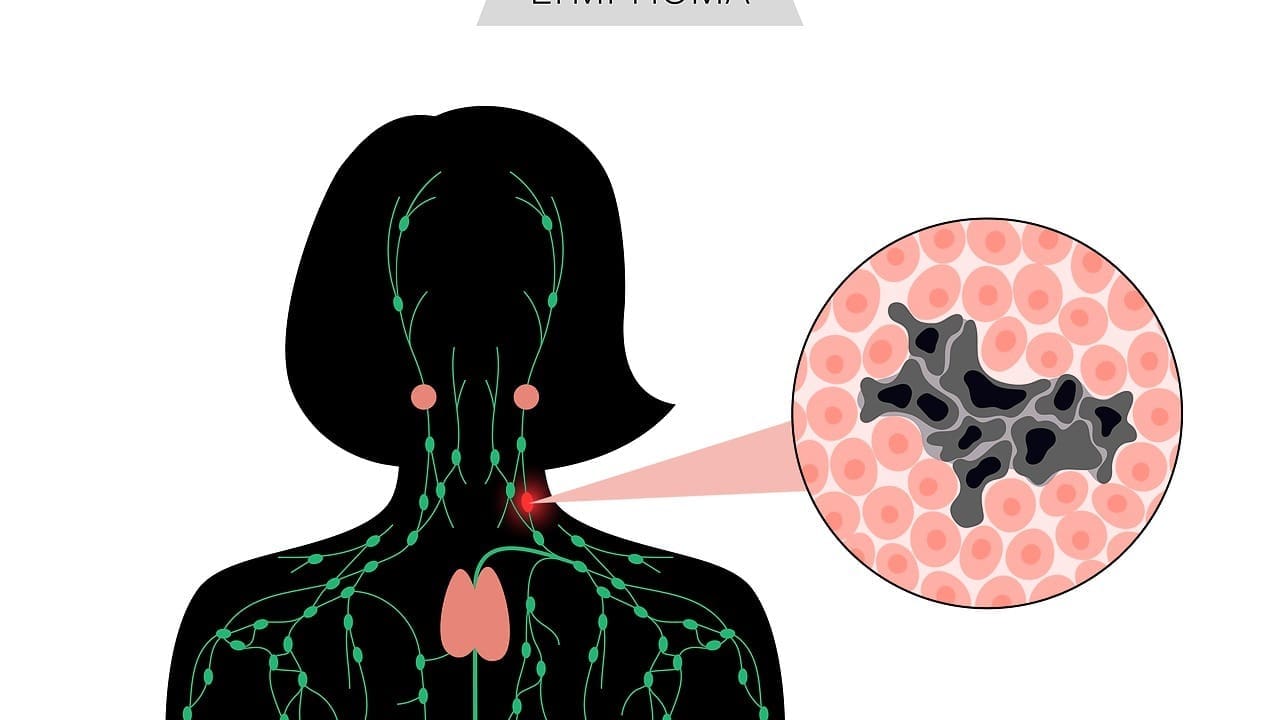Last Updated on November 26, 2025 by Bilal Hasdemir

Understanding diffuse large B-cell lymphoma (DLBCL) is key for patients and families. We aim to offer evidence-based care and better outcomes for each case.
DLBCL is a fast-growing type of non-Hodgkin lymphoma. When it’s at stage 3, it needs quick and effective treatment. Chemoimmunotherapy, like R-CHOP, is often used to treat it.
In this article, we’ll look at 7 important facts about DLBCL stage 3. We’ll cover its characteristics and treatment options. This will help you understand this condition better.
Key Takeaways
- Understanding DLBCL stage 3 is key for effective treatment.
- Chemoimmunotherapy is a common treatment approach.
- DLBCL is an aggressive type of non-Hodgkin lymphoma.
- Stage 3 DLBCL needs quick and effective treatment.
- Personalized care improves patient outcomes.
What is Diffuse Large B-Cell Lymphoma?
Knowing about Diffuse Large B-Cell Lymphoma (DLBCL) is key for those diagnosed. It’s a fast-growing non-Hodgkin lymphoma. It can start in lymph nodes or elsewhere.
Definition and Prevalence
DLBCL starts from B cells, a vital part of our immune system. It grows quickly, making it aggressive. The American Cancer Society says it’s the most common type, making up about 30% of non-Hodgkin lymphoma cases.
Prevalence: It mostly affects people over 60. But, it can happen to anyone.
Subtypes and Classifications
DLBCL is not just one type. It includes many with different features. There are several subtypes, like:
- Germinal center B-cell-like (GCB) DLBCL
- Activated B-cell-like (ABC) DLBCL
- Double-hit lymphoma
- Primary mediastinal large B-cell lymphoma
These subtypes are based on cell origin, genetic changes, and more. They help doctors decide on treatment and what to expect.
Risk Factors and Causes
The exact cause of DLBCL is not known. But, some risk factors have been found. These include:
- Being immunosuppressed, like with HIV/AIDS
- Having infections, like Epstein-Barr virus (EBV)
- Autoimmune diseases, like rheumatoid arthritis
- Being exposed to certain chemicals or pesticides
A leading oncologist says,
“Genetics and environment both play a role in DLBCL. It’s a complex disease.”
Knowing these risk factors helps in early detection and treatment of DLBCL.
Understanding Lymphoma Staging Systems
Lymphoma staging systems are key tools for doctors to understand the disease’s spread. They help classify lymphoma within the body. This is vital for predicting outcomes and planning treatments.
The Ann Arbor Staging System
The Ann Arbor Staging System is widely used for lymphomas, like Diffuse Large B-Cell Lymphoma (DLBCL). It was developed in the 1970s. It divides lymphoma into four stages based on lymph node involvement and extranodal disease.
Stage I: Involvement of a single lymph node group or lymphoid structure.
Stage II: Involvement of two or more lymph node groups on the same side of the diaphragm.
Stage III: Involvement of lymph node groups on both sides of the diaphragm.
Stage IV: Diffuse or disseminated involvement of one or more extralymphatic organs, with or without associated lymph node involvement.
| Stage | Description |
|---|---|
| I | Single lymph node group or lymphoid structure involved |
| II | Two or more lymph node groups on the same side of the diaphragm involved |
| III | Lymph node groups on both sides of the diaphragm involved |
| IV | Extralymphatic organs involved, with or without lymph node involvement |
Additional Staging Factors
The Ann Arbor Staging System is a basic tool. But, other factors are also important for staging and treatment planning. Bulky disease and B symptoms are two key factors.
Bulky Disease: This is a large mass of lymphoma cells, over 7.5 cm in diameter. It often means the lymphoma is more aggressive and needs intense treatment.
B Symptoms: These are symptoms like fever, night sweats, and unexplained weight loss. They can mean the disease is more advanced or aggressive.
“The presence of B symptoms and bulky disease can significantly impact the prognosis and treatment of lymphoma patients,” said a leading hematologist.
Importance of Accurate Staging for Treatment Planning
Accurate staging is key for effective treatment planning. It helps doctors understand the disease spread, identify complications, and choose the right therapy. Wrong staging can lead to bad outcomes, like undertreatment or overtreatment.
Understanding the Ann Arbor Staging System and other factors helps healthcare providers tailor treatments. This ensures each patient gets the care they need.
Diffuse Large B-Cell Lymphoma Stage 3: Key Characteristics
In Stage 3 DLBCL, the disease has spread to lymph nodes on both sides of the diaphragm. This stage is key to understanding how far the disease has spread. It helps doctors plan the right treatment.
Anatomical Distribution in Stage 3
Stage 3 DLBCL means lymph nodes on both sides of the diaphragm are involved. The disease has moved from one group of lymph nodes to another. This shows the disease is widespread, needing a detailed treatment plan.
Lymph Node Involvement Patterns
The way lymph nodes are involved in Stage 3 DLBCL varies. It usually affects many lymph node groups, both above and below the diaphragm. The disease can spread in different ways, affecting various lymph node areas. Knowing these patterns is key for accurate staging and treatment.
Prevalence of Stage 3 DLBCL
Stage 3 DLBCL makes up about 25-35% of all DLBCL cases. This shows how important this stage is in managing DLBCL. Early detection and the right treatment can greatly improve patient outcomes at this stage.
Every patient’s journey with DLBCL is different. Understanding Stage 3’s specific traits is essential for both doctors and patients. By knowing the anatomical distribution, lymph node involvement, and prevalence of Stage 3 DLBCL, we can tackle this condition better. This leads to better treatment plans.
Comparing Stage 2 B-Cell Lymphoma and Stage 3 DLBCL
Stage 2 B-cell lymphoma and Stage 3 DLBCL have different lymph node involvement and symptoms. Knowing these differences is key for effective treatment.
Anatomical Differences in Lymph Node Involvement
The main difference between Stage 2 and Stage 3 DLBCL is in lymph node involvement. Stage 2 B-cell lymphoma affects two or more lymph node groups on one side of the diaphragm. On the other hand, Stage 3 DLBCL affects lymph nodes on both sides of the diaphragm, showing a more widespread disease.
This difference is important because it shows how far the disease has spread. The diaphragm is a muscle that separates the chest and abdominal cavities. It’s a key landmark in lymphoma staging.
Symptom Variations Between Stages
As DLBCL moves from Stage 2 to Stage 3, symptoms can change. These symptoms can affect daily life in different ways. Common symptoms include:
- B symptoms: fever, night sweats, and unexplained weight loss
- Lymphadenopathy: swollen lymph nodes that can cause discomfort or pain
- Fatigue: persistent tiredness that can affect daily activities
In Stage 3, symptoms can be more severe. For example, a patient with Stage 3 DLBCL might feel more tired or have more swollen lymph nodes.
“The progression of DLBCL from Stage 2 to Stage 3 not only changes the anatomical extent of the disease but also potentially intensifies the symptoms, requiring a more aggressive and more complete treatment approach.”
Treatment Approach Differences
Treatment for Stage 2 and Stage 3 DLBCL can be different. While R-CHOP chemoimmunotherapy is common for both, Stage 3 might need more intense treatment.
For example, Stage 3 DLBCL patients might need:
- More cycles of chemotherapy
- Additional targeted therapy
- More frequent follow-up assessments to monitor treatment response and possible side effects
In some cases, clinical trials with new treatments might be available for Stage 3 patients. This offers chances for new therapies.
Every patient’s journey with DLBCL is unique. Treatment plans are made to fit each person’s needs and health. Knowing the differences between Stage 2 and Stage 3 DLBCL helps patients and doctors make better care choices.
Stage 4 Diffuse Large B-Cell Lymphoma: The Next Level
In Stage 4 DLBCL, cancer spreads beyond lymph nodes to vital organs. This stage is a big step up, marked by extranodal involvement.
Extranodal Organ Involvement in Stage 4
Stage 4 DLBCL means cancer has reached extranodal organs, outside the lymph system. Organs like the liver, bone marrow, and gut are often hit. This makes treatment harder and needs a detailed plan.
- Liver involvement can lead to liver function test issues.
- Bone marrow infiltration may cause blood cell count problems.
- Gastrointestinal tract involvement can cause symptoms like abdominal pain or bowel obstruction.
Common Sites of Metastasis
Cancer cells in Stage 4 DLBCL often spread to key organs like the bone marrow and liver. Knowing where cancer spreads is key for a good treatment plan.
- Bone Marrow: Involvement here can lead to anemia, neutropenia, or thrombocytopenia.
- Liver: Metastasis to the liver may cause elevated liver enzymes and affect its detoxifying role.
Unique Challenges of Advanced Disease
Stage 4 DLBCL brings big challenges due to its advanced state and organ system involvement. Managing it needs a team effort, including chemotherapy, targeted therapy, and care for symptoms. This aims to improve quality of life.
Dealing with Stage 4 DLBCL is tough, but the right care can help. Our team is dedicated to providing detailed care for each patient’s needs.
7 Critical Symptoms of Stage 3 DLBCL
Knowing the symptoms of stage 3 DLBCL is key to better treatment. This stage has symptoms that can affect daily life in different ways.
Lymphadenopathy Patterns
Lymphadenopathy, or swollen lymph nodes, is a main sign of DLBCL. In stage 3, this symptom is more noticeable. The disease affects lymph nodes on both sides of the diaphragm.
Common patterns of lymphadenopathy include:
- Enlarged lymph nodes in the neck, armpits, or groin
- Painless swelling, which can be tender if there’s associated inflammation
- Multiple lymph node groups involved, indicating widespread disease
B Symptoms: Fever, Night Sweats, Weight Loss
B symptoms affect a patient’s quality of life. These include:
| Symptom | Description |
|---|---|
| Fever | Elevated body temperature, often above 38°C, which can occur intermittently |
| Night Sweats | Recurring episodes of drenching sweats at night, often soaking bedclothes |
| Weight Loss | Significant unintentional weight loss, typically more than 10% of body weight over six months |
B symptoms suggest a more aggressive disease. They can also change treatment plans.
Other Common Manifestations
Patients with stage 3 DLBCL may also have:
- Fatigue and weakness, impacting daily activities
- Loss of appetite, potentially leading to malnutrition
- Shortness of breath, if the disease involves the chest or affects the lungs indirectly
Spotting these symptoms early can lead to better treatment. This can improve outcomes for stage 3 DLBCL patients.
Diagnostic Workup for Stage 3 DLBCL
To diagnose Stage 3 Diffuse Large B-Cell Lymphoma (DLBCL), doctors use several methods. They perform biopsy procedures, imaging studies, and laboratory tests. This detailed approach helps in accurate staging and treatment planning.
Essential Biopsy Procedures
A biopsy is key in diagnosing DLBCL. An excisional biopsy is recommended to get enough tissue for analysis. This means removing a whole lymph node or a big part of the affected area.
“The biopsy’s accuracy is vital for diagnosing DLBCL and figuring out its stage,” says Dr. Jane Smith, a top hematologist. “A good tissue sample lets us do detailed tests, like looking at cells under a microscope and studying their genes.”
Imaging Studies (PET-CT, MRI)
Imaging tests are important for staging DLBCL. PET-CT (Positron Emission Tomography-Computed Tomography)
In some cases, MRI (Magnetic Resonance Imaging) is used. It helps check specific areas, like the brain or organs like the liver or spleen.
Laboratory Tests and Biomarkers
Lab tests are vital to confirm the diagnosis and understand the lymphoma’s biology. Important tests include:
- Complete Blood Count (CBC) to check blood cell counts
- Lactate Dehydrogenase (LDH) levels, which can be high in DLBCL
- Immunohistochemistry to spot specific markers on cells
- Molecular studies, like FISH (Fluorescence In Situ Hybridization), to find genetic changes
Biomarkers, like CD20, are important for diagnosing DLBCL and choosing treatments. Combining these tests helps doctors understand the disease well. This makes it easier to create a treatment plan that fits each patient.
Standard Treatment Protocols for Stage 3 Diffuse Large B-Cell Lymphoma
Managing Stage 3 DLBCL requires a detailed plan. This includes R-CHOP and Pola-R-CHP treatments. These options help patients deal with their condition effectively.
R-CHOP Chemoimmunotherapy Regimen
The R-CHOP regimen is a key treatment for DLBCL. It combines rituximab with cyclophosphamide, doxorubicin, vincristine, and prednisone. This approach has greatly improved treatment outcomes for Stage 3 patients.
The R-CHOP regimen targets cancer cells effectively. Rituximab attacks B cells, while the chemotherapy kills fast-growing cells.
Newer Pola-R-CHP Treatment Option
Pola-R-CHP is a newer treatment option. It adds polatuzumab vedotin to R-CHP. This combination has shown better results in some patients.
Treatment Duration and Response Assessment
R-CHOP or Pola-R-CHP treatment lasts several cycles, given every 21 days. Usually, 6 cycles are given. PET-CT scans and other tools check how well the lymphoma responds to treatment.
Managing Treatment Side Effects
Dealing with side effects is key in DLBCL treatment. R-CHOP and Pola-R-CHP can cause fatigue, nausea, hair loss, and infections. Medications help prevent these side effects, improving the patient’s life during treatment.
Prognosis and Survival Rates
The outlook for Stage 3 Diffuse Large B-Cell Lymphoma has greatly improved. This is thanks to new treatments. We will look at the current survival rates and what affects them for patients with this stage of DLBCL.
Five-Year Survival Statistics for Stage 3
Recent studies show that the five-year survival rate for Stage 3 DLBCL varies. This depends on age, overall health, and how well the treatment works. Generally, the five-year survival rate for DLBCL is about 60-70%. Stage 3 falls within this range.
Key statistics to consider:
- Overall 5-year survival rate for DLBCL: 60-70%
- Stage 3 DLBCL 5-year survival rate: approximately 50-60%
- Survival rates have improved with the introduction of R-CHOP therapy
Prognostic Factors Affecting Outcomes
Several factors are important in determining the outcome for Stage 3 DLBCL patients. These include:
- International Prognostic Index (IPI): A scoring system that looks at age, stage, LDH levels, performance status, and extranodal involvement.
- Genetic characteristics: Certain genetic features, such as double-hit lymphoma, can impact prognosis.
- Response to initial treatment: Patients who achieve complete remission after initial treatment generally have a better prognosis.
A recent study found that “The International Prognostic Index remains a key tool in assessing prognosis for DLBCL patients. It guides treatment decisions and risk stratification.”
“Advances in chemoimmunotherapy have significantly improved outcomes for DLBCL patients, including those with Stage 3 disease.”
Comparison with Other DLBCL Stages
When comparing Stage 3 DLBCL to other stages, it’s important to consider how prognosis varies. This helps us understand the differences in disease stages.
| DLBCL Stage | 5-Year Survival Rate | Prognostic Factors |
|---|---|---|
| Stage 1 | 70-80% | Limited disease, fewer comorbidities |
| Stage 3 | 50-60% | More extensive lymph node involvement |
| Stage 4 | 40-50% | Extranodal organ involvement, potentially more aggressive disease |
We continue to see improvements in survival rates across all stages of DLBCL. This is thanks to ongoing research and advancements in treatment protocols.
Living with Stage 3 DLBCL: Patient Perspectives
Living with Stage 3 Diffuse Large B-Cell Lymphoma means more than just treatment. It’s about having a strong support system too. Patients go through a lot, from understanding their diagnosis to dealing with treatment’s effects.
Looking at the patient experience, we see many important factors. These include coping during treatment and living well after it. We’ll look at what helps patients do better and feel better.
Coping Strategies During Treatment
Dealing with Stage 3 DLBCL during treatment is tough. It affects both body and mind. Good coping strategies can really help a patient’s life quality.
- Staying Informed: Knowing about treatment and side effects makes patients feel more in charge.
- Building a Support Network: Family, friends, and groups offer vital emotional support.
- Maintaining Physical Health: Gentle exercise and healthy eating can help with side effects.
- Managing Stress: Activities like meditation, yoga, or therapy can lessen stress and anxiety.
A study on lymphoma research shows how important support systems are for patients.
Support Resources and Communities
Right support resources and communities can greatly help patients. They offer emotional support and practical advice.
| Resource Type | Description | Benefits |
|---|---|---|
| Support Groups | Groups of patients and survivors sharing experiences | Emotional support, shared knowledge |
| Online Forums | Online communities for discussion and advice | Accessibility, diverse perspectives |
| Counseling Services | Professional counseling for emotional support | Personalized guidance, stress management |
As one patient said, “
The support group was a lifeline for me. It helped me understand I wasn’t alone in this journey.
“
Long-term Survivorship Considerations
For those who’ve finished treatment, survivorship is key. It’s about watching for signs of cancer coming back, dealing with treatment’s late effects, and keeping overall health good.
Follow-up Care is vital, with regular check-ups and screenings. Patients should also know about late effects like secondary cancers or organ damage.
Understanding Stage 3 DLBCL helps patients manage their diagnosis and treatment better. This improves their life quality and outcomes.
Conclusion: Navigating Your DLBCL Journey
Understanding Diffuse Large B-Cell Lymphoma (DLBCL) and its treatment is key for patients. Stage 3 DLBCL brings its own set of challenges. But, with the right info and support, patients can make smart choices about their care.
To navigate your DLBCL journey, you need to know a lot. This includes the disease, its stages, and treatment plans. Knowing about Stage 3 DLBCL and treatment options helps patients deal with the disease better.
Having a strong support network is vital for patients with DLBCL. We offer top-notch healthcare and support to help international patients. This way, they can face their DLBCL journey with confidence.
What is Diffuse Large B-Cell Lymphoma (DLBCL)?
DLBCL is a fast-growing cancer of the B cells in the lymph nodes. It needs quick treatment.
What are the symptoms of stage 3 DLBCL?
Symptoms include swollen lymph nodes and B symptoms like fever and weight loss. Fatigue and loss of appetite are also common.
How is DLBCL staged?
DLBCL is staged using the Ann Arbor System. It divides the disease into four stages based on lymph node involvement and extranodal disease.
What is the difference between stage 2 B-cell lymphoma and stage 3 DLBCL?
Stage 2 B-cell lymphoma affects one side of the diaphragm. Stage 3 DLBCL affects both sides, showing a wider spread.
What are the treatment options for stage 3 DLBCL?
Treatments include chemoimmunotherapy like R-CHOP or pola-R-CHP. The goal is to achieve complete remission.
What is the prognosis for stage 3 DLBCL?
The prognosis depends on health, treatment response, and specific markers. Five-year survival rates give a general outlook.
How is stage 4 DLBCL different from stage 3?
Stage 4 DLBCL involves extranodal organs like the bone marrow or liver. This indicates a more advanced disease than stage 3.
What are the common sites of metastasis in DLBCL?
Metastasis often occurs in the bone marrow, liver, and other organs. These are common in advanced stages.
How is DLBCL diagnosed?
Diagnosis involves biopsy, imaging like PET-CT, and lab tests. These confirm cancer and determine the stage.
What are the key factors that affect the prognosis of DLBCL?
Factors include disease stage, age, performance status, B symptoms, and biomarkers. These influence treatment outcomes.
What is the role of R-CHOP in treating DLBCL?
R-CHOP is a standard treatment for DLBCL. It combines rituximab with chemotherapy for stage 3 disease.
Are there any new treatments available for DLBCL?
Yes, treatments like pola-R-CHP offer better options for those not responding to traditional therapies.
References
- Melchardt T, et al. How I treat diffuse large B-cell lymphoma. PMC; 2023. Available from: https://pmc.ncbi.nlm.nih.gov/articles/PMC9843196/ (PMC)
- Blood Cancer UK. DLBCL Treatment (Diffuse Large B-Cell Lymphoma). Available from: https://bloodcancer.org.uk/understanding-blood-cancer/lymphoma/diffuse-large-b-cell-lymphoma-dlbcl/dlbcl-treatment/
- American Cancer Society. Treating B-Cell Lymphoma (Non-Hodgkin Lymphoma). Available from: https://www.cancer.org/cancer/types/non-hodgkin-lymphoma/treating/b-cell-lymphoma.html
- Cancer Support Community. Diffuse Large B Cell Lymphoma (DLBCL). Available from: https://www.cancersupportcommunity.org/diffuse-large-b-cell-lymphoma-dlbcl (cancersupportcommunity.org)
- Lymphoma Research Foundation. Diffuse Large B-Cell Lymphoma: Treatment Options. Available from: https://lymphoma.org/understanding-lymphoma/aboutlymphoma/nhl/dlbcl/dlbcltreatment/ (Lymphoma Research Foundation)








